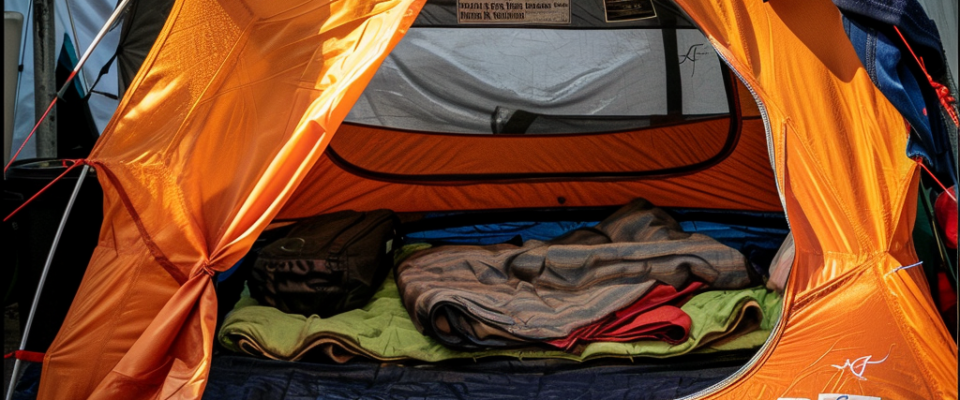A tent is your home in the wild, your refuge from bad weather, insects and other troubles. Choosing the right tent is an important step for any hiking or camping trip. However, before making a choice, it is important to understand what size tent is most suitable for your needs.
Tent size
Tent size is one of the most important aspects when choosing. It is determined mainly by the number of sleeping spaces and the level of comfort you require while hiking or camping.
- Number of beds:
- If you are traveling alone, a one-person tent is the best choice. It is compact and lightweight, making it easy to carry.
- For two people, two-person tents are the most common. They provide enough space for two sleepers and some personal items.
- If you need space for more people, choose multi-person tents. They can accommodate from three to several dozen sleepers, depending on the model.
- Comfort:
- Please note that in the tent you will need space not only for sleeping bags, but also for personal belongings. Choose a tent with extra storage space if you prefer to have some convenience.
- Don’t forget about the height of the tent. Tall models provide more vertical freedom and convenience when changing clothes.
- Portability:
- Keep in mind that larger tents are usually heavier and take up more space when packed. If you need the most compact and lightweight equipment, choose a tent with a minimum size sufficient for your comfort.
Choosing a tent size depends on your individual needs, the number of people sleeping, and the level of comfort you want while camping.
Tent weight
The weight of the tent is another important factor when choosing, especially if you are planning multi-pass hikes or long trips. Considering that every gram counts, especially when you’re carrying gear on your back, choosing a tent that’s lightweight and compact can go a long way toward lightening your load.
- Materials:
- Tents made from modern lightweight materials such as siliconized nylon or polyester usually weigh less and are compact in size. However, they may be less durable and require careful handling.
- Tents made from ultra-light materials such as carbon fibers or expensive fabrics can be even lighter, but they can also have a higher cost.
- Construction:
- Lightweight and compact tents usually have simple designs without unnecessary elements such as large apexes or additional compartments.
- The weight of the tent also depends on its size and capacity. Larger tents, which can accommodate more people, usually weigh more.
- Convenience and compromise:
- When choosing a tent, it is important to find a balance between weight and comfort. The lighter the tent, the more comfortable it is to carry, but it may also have limitations on space and comfort.
- Keep in mind that there is a trade-off between weight and strength. Lighter materials may be less strong and less durable.
Tent design type
The type of tent construction affects its strength, wind resistance and water resistance, as well as ease of use and space inside. Here are some of the most common types of tents:
- Dome Tents:
- These tents have an arched design that creates a stable shape and provides good wind resistance.
- Dome tents are typically lightweight and easy to set up, making them a popular choice for hiking and camping.
- Tunnel tents:
- Tunnel tents have a long, thin shape and are supported by arches that run parallel to each other.
- They provide plenty of space inside and can be wind resistant when set up correctly, but are less stable than dome tents.
- Geodetic tents:
- These tents have a complex arc design that provides high stability and wind resistance.
- Geodesic tents are often used for extreme conditions and high mountain treks due to their durable design.
Ventilation accounting
Good tent ventilation plays a key role in ensuring a comfortable stay inside.When choosing a tent, you should pay attention to the presence of vents and ventilation systems that will provide fresh air inside the tent and reduce condensation. This is especially important in humid or warm weather when the inside of the tent can become hot and stuffy.
Insect-proof and waterproof
When living outdoors, protection from insects plays an important role in ensuring a comfortable sleep. The tent should be equipped with mosquito nets on the windows and doors to prevent insects from entering and ensure a restful sleep without constantly fighting mosquitoes, flies and other annoying insects.
Reliable rain protection is an important aspect when choosing a tent. Check what material the walls and floor of the tent are made of and how waterproof they are. The tent must have a high-quality waterproof coating, as well as welded seams to prevent moisture from penetrating inside and ensure a dry and comfortable stay inside even during heavy rain.
When choosing a tent for hiking or camping, you need to consider not only its size and weight, but also a number of additional factors such as ventilation, insect protection and waterproofness. A well-thought-out choice of tent will provide you with a comfortable and safe stay in nature, allowing you to enjoy the surrounding nature without unnecessary inconvenience.
Good ventilation of the tent provides fresh air inside, prevents the formation of condensation and creates comfortable conditions for sleep and rest.
In addition to ventilation and protection from insects, it is necessary to pay attention to the waterproofness of materials and the quality of the tent’s construction to ensure protection from bad weather and other unforeseen circumstances in the outdoors.

